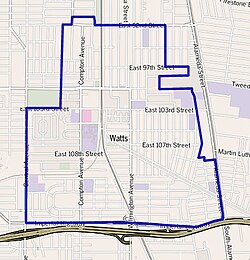Watts, Los Angeles
| Watts | |
|---|---|
| Neighborhood of Los Angeles | |

Watts' most famous landmark, the Watts Towers created by Simon Rodia
|
|
 Watts as mapped by the Los Angeles Times |
|
| Location within the Greater Los Angeles Area | |
| Coordinates: 33°56′30″N 118°14′30″W / 33.94167°N 118.24167°W | |
| Country | United States |
| State | California |
| County | County of Los Angeles |
| City | City of Los Angeles |
| Government | |
| • City Council | Joe Buscaino |
| • State Assembly | Isadore Hall, III (D) |
| • State Senate | Roderick Wright (D) |
| • U.S. House | Janice Hahn (D) |
| Area | |
| • Total | 2.0 sq mi (5 km2) |
| Population (2000) | |
| • Total | 34,830 |
| • Density | 17,350/sq mi (6,700/km2) |
| ZIP Code | 90002 |
| Area code(s) | 323 |
Watts is a 2.12-square-mile neighborhood in Los Angeles, California, within the South Los Angeles area. It is a high-density, youthful neighborhood with a large household size and with the highest percentage of families headed by single parents in the city.
The district was once a separate city but was consolidated with Los Angeles in 1926. As a major junction of railroad lines, Watts attracted many railroad workers as residents. The Watts railroad station is on the National Register of Historic Places.
Watts is noted for the Watts Towers and for the 1965 Watts riots. The neighborhood also has a number of youth gangs. Residents engage in civic activities such as cycling, a toy drive, a Christmas parade and an athletic tournament. There is a local theatre and a dance company. There is one library branch, and there are four high schools. Watts has been the site of motion picture filming.
The area now known as Watts is located on the 1843 Rancho La Tajauta Mexican land grant. As on all ranchos, the principal vocation was at that time grazing and beef production.
With the influx of European American settlers into Southern California in the 1870s, La Tajuata land was sold off and subdivided for smaller farms and homes, including a 220-acre parcel purchased by Charles H. Watts in 1886 for alfalfa and livestock farming. In those days each Tajuata farm had an artesian well.
The arrival of the railroad spurred the settlement and development of the area. Most of the first residents were the traqueros, Mexican and Mexican American rail workers who constructed and maintained the new rail lines.
With this new growth, Watts was incorporated as a separate city, taking its name from the first railroad station, Watts Station that had been built in 1904 on 10 acres of land donated by the Watts family. The city voted to annex itself to Los Angeles in 1926.
Watts did not become predominantly black until the 1940s. Before then, there were some African American residents, many of whom were Pullman car porters and cooks. Schoolroom photos from 1909 and 1911 show only two or three black faces among the 30 or so children pictured. By 1914, a black realtor, Charles C. Leake, was doing business in the area. Racially restrictive covenants prevented blacks from living in any other neighborhoods outside of Central Avenue District and Watts.
...
Wikipedia

